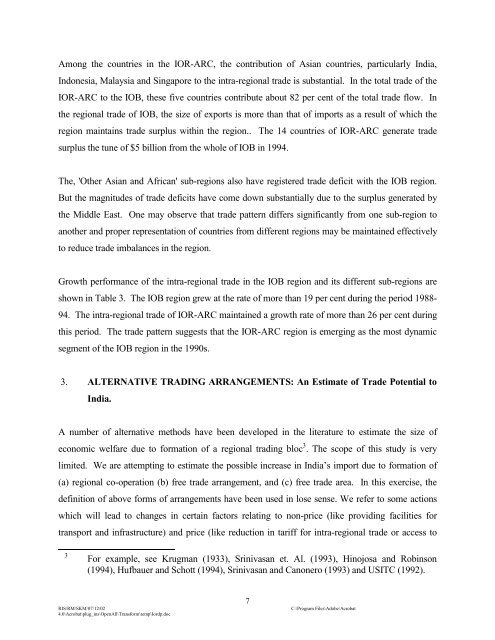dp11_pap
dp11_pap
dp11_pap
You also want an ePaper? Increase the reach of your titles
YUMPU automatically turns print PDFs into web optimized ePapers that Google loves.
Among the countries in the IOR-ARC, the contribution of Asian countries, particularly India,<br />
Indonesia, Malaysia and Singapore to the intra-regional trade is substantial. In the total trade of the<br />
IOR-ARC to the IOB, these five countries contribute about 82 per cent of the total trade flow. In<br />
the regional trade of IOB, the size of exports is more than that of imports as a result of which the<br />
region maintains trade surplus within the region.. The 14 countries of IOR-ARC generate trade<br />
surplus the tune of $5 billion from the whole of IOB in 1994.<br />
The, 'Other Asian and African' sub-regions also have registered trade deficit with the IOB region.<br />
But the magnitudes of trade deficits have come down substantially due to the surplus generated by<br />
the Middle East. One may observe that trade pattern differs significantly from one sub-region to<br />
another and proper representation of countries from different regions may be maintained effectively<br />
to reduce trade imbalances in the region.<br />
Growth performance of the intra-regional trade in the IOB region and its different sub-regions are<br />
shown in Table 3. The IOB region grew at the rate of more than 19 per cent during the period 1988-<br />
94. The intra-regional trade of IOR-ARC maintained a growth rate of more than 26 per cent during<br />
this period. The trade pattern suggests that the IOR-ARC region is emerging as the most dynamic<br />
segment of the IOB region in the 1990s.<br />
3. ALTERNATIVE TRADING ARRANGEMENTS: An Estimate of Trade Potential to<br />
India.<br />
A number of alternative methods have been developed in the literature to estimate the size of<br />
economic welfare due to formation of a regional trading bloc 3 . The scope of this study is very<br />
limited. We are attempting to estimate the possible increase in India’s import due to formation of<br />
(a) regional co-operation (b) free trade arrangement, and (c) free trade area. In this exercise, the<br />
definition of above forms of arrangements have been used in lose sense. We refer to some actions<br />
which will lead to changes in certain factors relating to non-price (like providing facilities for<br />
transport and infrastructure) and price (like reduction in tariff for intra-regional trade or access to<br />
3<br />
For example, see Krugman (1933), Srinivasan et. Al. (1993), Hinojosa and Robinson<br />
(1994), Hufbauer and Schott (1994), Srinivasan and Canonero (1993) and USITC (1992).<br />
7<br />
RIS/RM/SKM/07/12/02 C:\Program Files\Adobe\Acrobat<br />
4.0\Acrobat\plug_ins\OpenAll\Transform\temp\Iordp.doc
















